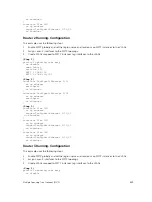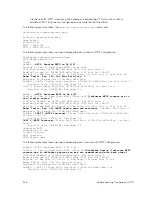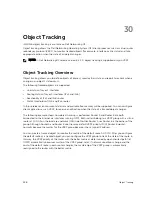
Protocol
Ethernet Address
PIM-SM
01:00:5e:00:00:0d
• The Dell Networking OS implementation of MTRACE is in accordance with IETF draft
draft-fenner-
traceroute-ipm
.
• Multicast is not supported on secondary IP addresses.
• Egress L3 ACL is not applied to multicast data traffic if you enable multicast routing.
First Packet Forwarding for Lossless Multicast
All initial multicast packets are forwarded to receivers to achieve lossless multicast.
In previous versions, when the Dell Networking system is an RP, all initial packets are dropped until PIM
creates an (S,G) entry. When the system is an RP and a Source DR, these initial packet drops represent a
loss of native data, and when the system is an RP only, the initial packets drops represent a loss of register
packets.
Both scenarios might be unacceptable depending on the multicast application. When the Dell
Networking system is the RP, and has receivers for a group G, it forwards all initial multicast packets for
the group based on the (*,G) entry rather than discarding them until the (S,G) entry is created, making Dell
Networking systems suitable for applications sensitive to multicast packet loss.
NOTE: When a source begins sending traffic, the Source DR forwards the initial packets to the RP as
encapsulated registered packets. These packets are forwarded via the soft path at a maximum rate
of 70 packets/second. Incoming packets beyond this rate are dropped.
Multicast Policies
Dell Networking OS offers parallel multicast features for IPv4.
•
IPv4 Multicast Policies
The following sections describe IPv4 multicast policies.
•
Limiting the Number of Multicast Routes
•
Preventing a Host from Joining a Group
•
Preventing a PIM Router from Forming an Adjacency
•
Preventing a Source from Registering with the RP
•
Preventing a PIM Router from Processing a Join
Limiting the Number of Multicast Routes
When the total number of multicast routes on a system limit is reached, Dell Networking OS does not
process any IGMP or multicast listener discovery protocol (MLD) joins to PIM — though it still processes
leave messages — until the number of entries decreases below 95% of the limit.
When the limit falls below 95% after hitting the maximum, the system begins relearning route entries
through IGMP, MLD, and MSDP.
• If the limit is increased after it is reached, join subsequent join requests are accepted. In this case,
increase the limit by at least 10% for IGMP and MLD to resume.
530
Multicast Features
Summary of Contents for Z9000
Page 1: ...Dell Configuration Guide for the Z9000 System 9 7 0 0 ...
Page 80: ...grub reboot 80 Management ...
Page 128: ... 0 Te 1 1 Te 1 2 rx Flow N A N A 128 Access Control Lists ACLs ...
Page 491: ...Figure 70 Configuring OSPF and BGP for MSDP Multicast Source Discovery Protocol MSDP 491 ...
Page 496: ...Figure 73 MSDP Default Peer Scenario 1 496 Multicast Source Discovery Protocol MSDP ...
Page 497: ...Figure 74 MSDP Default Peer Scenario 2 Multicast Source Discovery Protocol MSDP 497 ...
Page 498: ...Figure 75 MSDP Default Peer Scenario 3 498 Multicast Source Discovery Protocol MSDP ...
Page 760: ...Figure 100 Single and Double Tag TPID Match 760 Service Provider Bridging ...
Page 761: ...Figure 101 Single and Double Tag First byte TPID Match Service Provider Bridging 761 ...















































